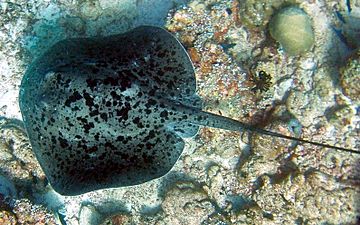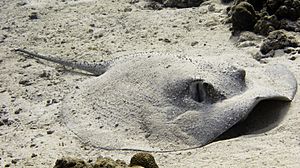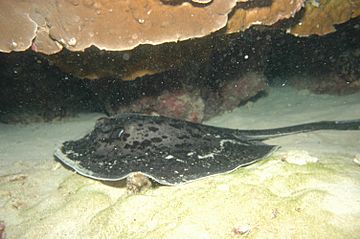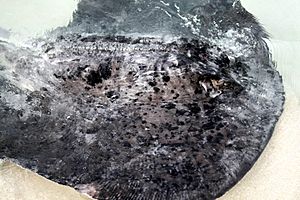Round ribbontail ray facts for kids
The round ribbontail ray (Taeniura meyeni) is a type of stingray found in the warm, shallow waters of the Indo-Pacific Ocean and around some islands in the eastern Pacific Ocean. This large ray lives on the ocean floor in lagoons, estuaries, and reefs, usually at depths of 20 to 60 meters (66 to 200 feet). It can grow up to 1.8 meters (5.9 feet) wide.
This ray has a thick, round body covered with small bumps on top. Its tail is quite short and has a deep fin fold underneath. It has a unique pattern of light and dark spots on its upper side, and its tail is black. The round ribbontail ray is usually active at night. It hunts for small molluscs, crustaceans, and small bony fishes on the seabed.
Female rays give birth to live young, usually up to seven pups at a time. While not aggressive, the ray will use its venomous tail spine if it feels threatened. It is popular with divers who enjoy seeing marine life and with people who fish for fun. However, this ray reproduces slowly and is threatened by fishing and damage to its home. Because of this, the International Union for the Conservation of Nature (IUCN) lists it as a Vulnerable species.
Quick facts for kids Round ribbontail ray |
|
|---|---|
 |
|
| Conservation status | |
| Scientific classification | |
| Genus: |
Taeniurops
|
| Species: |
meyeni
|
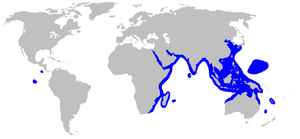 |
|
| Range of the round ribbontail ray | |
| Synonyms | |
|
|
Contents
About Its Name
The round ribbontail ray was first described in 1841 by two German scientists, Johannes Peter Müller and Friedrich Gustav Jakob Henle. They gave it the scientific name Taeniura meyeni.
This ray has many other common names, like black-blotched stingray, fantail ray, giant reef ray, and speckled stingray. In Australia, it is sometimes called a "bull ray."
What Does It Look Like?
The round ribbontail ray has a very thick, round body that is wider than it is long. Its outer edges are smooth and curved. It has medium-sized eyes, followed by larger holes called spiracles that help it breathe.
Between its oval nostrils, there's a short, wide flap of skin. The ray's mouth is wide and curved. Inside its mouth, there are small bumps called papillae on the floor. It has many rows of small teeth that fit together tightly, forming flat surfaces.
Its pelvic fins are small and narrow. The tail is fairly short, not longer than the body's width. On top of the tail, there is usually one (sometimes two) long, sharp, stinging spines. The tail is wide at the base, but quickly gets thinner after the spine. It has a deep fin fold on its underside that goes all the way to the tip.
The top of the ray's body and tail feels rough because it's covered in small, spread-out bumps called granules. There's also a line of sharp bumps down the middle of its back, with two shorter lines next to it. These bumps start to grow when the ray is about 46 centimeters (18 inches) long.
The ray's color on top can be light to dark gray, brownish-gray, or purplish. This color is darkest near the edges of its fins. It has a very unique pattern of irregular darker blotches and white spots or streaks. The tail, past the spine, is completely black. The underside of the ray is creamy-white, with darker edges on its fins and extra dots. Young rays have plainer colors than adult rays. This is one of the biggest stingray species, growing up to 1.8 meters (5.9 feet) wide, 3.3 meters (10.8 feet) long, and weighing up to 150 kilograms (330 pounds).
Where It Lives
The round ribbontail ray lives in many places across the Indo-Pacific region. You can find it from South Africa up the East African coast to the Red Sea, including places like Madagascar. Its range also stretches east through India to Southeast Asia and Micronesia. It can be found as far north as Korea and southern Japan, and as far south as Australia. In the eastern Pacific, it has been seen near Cocos Island and the Galápagos Islands.
This ray lives on the ocean floor, usually close to shore at depths of 20 to 60 meters (66 to 200 feet). However, it has been seen from the very shallow surf zone down to 439 meters (1,440 feet) deep. It prefers sandy or rocky bottoms in shallow lagoons or near coral and rocky reefs. It can also enter estuaries.
Life and Habits
The round ribbontail ray is a night animal. It rests quietly for most of the day, often near tall structures, in caves, or under ledges. It can be found alone or in small to large groups. Sometimes, smaller fish like jacks or cobia swim close to the ray. These smaller fish might eat food that the ray stirs up, or they might use the ray's body to hide while they hunt their own prey.
The round ribbontail ray hunts for bivalves (like clams), crabs, shrimps, and small bony fishes on the ocean bottom. When it's looking for food, it presses the edge of its body against the seabed. It then takes in water through its spiracles and blows it out through its mouth. This helps to uncover prey hidden in the sand. Larger fish, like sharks, and marine mammals might hunt this ray. If it feels threatened, it lifts its tail over its back so the spine points forward, and waves it back and forth.
Reproduction and Life Cycle
Not much is known about the full life cycle of the round ribbontail ray. Like other stingrays, the mother gives birth to live young. The baby rays first get their food from a yolk sac. Later, they are fed a special "uterine milk" (called histotroph) that the mother produces.
Large groups of these rays, sometimes hundreds, have been seen gathering to reproduce. This often happens when cooler temperatures arrive. During these times, one female ray might be followed by many males. Females can give birth to up to seven pups at a time. Each baby ray is about 33 to 35 centimeters (13 to 14 inches) wide and 67 centimeters (26 inches) long. In South Africa, births might happen in the summer. Male rays become ready to reproduce when they are about 1.0 to 1.1 meters (3.3 to 3.6 feet) wide. We don't know the exact size when females become ready to reproduce.
Humans and the Ray
The round ribbontail ray is not aggressive and sometimes even swims close to divers. However, if it is bothered, it can use its venomous tail spine to cause a serious injury. There has been at least one report of a person being seriously hurt by a ray after trying to ride it. This ray is very popular with divers who enjoy seeing marine life because of its large size and striking appearance.
The International Union for the Conservation of Nature (IUCN) has listed the round ribbontail ray as Vulnerable. This means it is at risk of becoming endangered. It cannot handle a lot of fishing because it reproduces slowly. Its coral reef home is also being damaged by things like pollution from farms and harmful fishing methods.
This ray is caught by both commercial and recreational fishers throughout its range, using lines and nets. In places like Indonesia, many large rays, including this one, are caught on purpose or by accident. All the rays caught are sold for people to eat.
Off South Africa, round ribbontail rays are sometimes caught by accident in nets used for catching shrimp, but they are not used for food there. Because of its size and strength, it is also a popular catch for sport fishers, who usually release it unharmed. South Africa has rules for recreational fishing, allowing only one ray per person per day and not allowing spearfishing for this species.
In Australia, this ray is considered to be of Least Concern. Even though it is caught by shrimp trawlers (and then thrown back), the number of rays caught has gone down because of special devices in nets that help rays escape. Also, part of its home in Australia is protected within the Great Barrier Reef Marine Park. The Maldives also lists this species as Least Concern. Because rays are important for tourism there, the government has created protected marine areas and banned the export of rays and ray skins.



